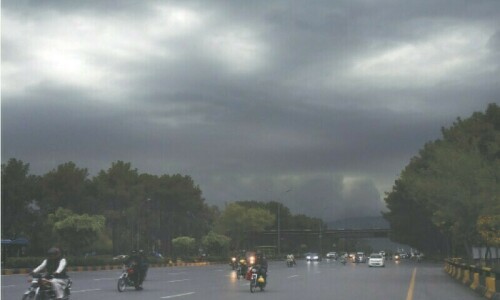
Entering the Freemason’s Lodge, one of Karachi’s few remaining vintage buildings, which houses the Sindh Wildlife Museum and Library in Civil Lines, is like travelling back in time.
Stepping into the museum hall, with its warm lighting and modern set-up, seems to freeze you in a time capsule between the past and present.
From the picture of a mongoose staring right into your eyes, another pictorial glimpse of a committee of vultures perched on a rocky hill, to a stuffed McQueen’s bustard, the aura of the room is nothing less than wildly magical.
Little do people know about the existence of a wildlife museum, that too in Karachi, where there are limited options for recreational public activity. The museum provides an overview of the rich and diverse wildlife found in Sindh, and aims at creating an awareness about its conservation.
Karachi’s renovated Sindh Wildlife Museum and Library is connecting the public to Sindh’s rich and diverse wildlife, and creating awareness about its conservation
With a vast and diverse landscape that offers perfect breeding grounds, and abundant food sources, Sindh hosts a variety of resident and migratory wildlife species. It is located along one of the main migratory routes for birds that leave the harsh weather conditions of Siberia in winter to move towards the equator.
While several wildlife photographers keep records of these migrations, and take special interest in these avian guests passing through the country, many people remain unaware of this spectacular natural phenomenon.

Unbeknownst to the Wildlife Department, a few years ago, there had been several wildlife photographers going on birding and wildlife photography expeditions to document the species found around and within the outskirts of the urban centres.
These species are often assumed to exist only as scavengers, while people generally relate birds with crows and kites, often mistaking kites as eagles. For the masses, the birds that are seen flying in Karachi are limited to crows, kites, and sparrows, while rose-ringed parakeets have almost become the birds of the past, given their diminishing numbers because of poaching.
Javed Mahar, conservator at the Sindh government’s Wildlife Department, bumped by chance into a group of passionate wildlife photographers at a wildlife photography/birding exhibition titled ‘Birds of Sindh’, which had been organised by the late Mirza Naim Beg.
“At the exhibition, I met this amazing group of wildlife lovers who regularly go on birding excursions and maintain records of the various bird and animal species they find,” recalls Mahar. “I was extremely pleased at the group’s diversity — it comprised youngsters, retired individuals, and female photographers, all pursuing their hobby.
“Given the idea of reviving the Sindh Wildlife Museum back to its former glory, I requested them to share their best photographs, to be displayed at the museum.”
Eventually, Mahar took these enthusiasts, comprising wildlife photographers and artists, on board, and curated a pictorial representation of Sindh’s wildlife with their help. With taxidermy specimens, photographs of local and migratory birds and animals, and watercolour prints, the museum is a treat for all ages.
Considering some wildlife habitats are still found in their original or less modified state, there are bound to be surprises for the observant eye, especially in the winter season, when migratory birds return in large numbers.

The Sindh Wildlife Museum had lay closed and in disrepair for a long time since the Wildlife Department was given low priority. However, the present provincial government responded positively and allocated a budget for it. Following rigorous renovation thanks to Mahar’s untiring efforts and vision, and an inauguration in February 2020 by PPP Chairman Bilawal Bhutto-Zardari, the museum has reopened for the public after 26 years.
Pandemic protocols were being strictly followed at the museum until recently, so entry was limited. But now, two to three schools visit each week, along with other wildlife enthusiasts, as the Covid protocols have been relaxed.
“The next step at the museum is digital cataloguing and documentation, and updating the latest data along with expansion of space,” says Mahar, emphasising the importance of collective wisdom and collaborative efforts; he believes that bringing the museum back to life could not have been a one-person job. The invaluable support of wildlife photographers as well as civil society has been noteworthy.
The museum displays over 240 bird species of the 326 species that have been documented in Sindh. But the species diversity is actually far greater in number. Tremendous effort has also been made to strictly ensure that taxidermy specimens are only of animals whose carcasses were the outcome of natural mortality, as opposed to sourcing a live animal.
Pupils and researchers in particular can also benefit from the Sindh Wildlife Library, just a floor above the museum. The oldest book in the library dates as far back as 200 years, while the library houses Sindh’s largest book reserve on wildlife, with up to 50,000 books on the subject. There are plans of digitising the entire library soon.
There is a dire need for such museums and educational centres to be developed, publicised, advertised and maintained for the public. They not only educate but also provide healthy and positive options for recreation, generate revenue and can pave the way for conservation and research opportunities as well.
There’s now little doubt that the Earth’s fauna and flora are in danger. While biodiversity loss is intensifying year after year, museums could have a role too in saving nature.
The writer is a communication professional, an artist and a wildlife photographer. She can be reached at moeen.hiba@gmail.com
Published in Dawn, EOS, April 10th, 2022














































Dear visitor, the comments section is undergoing an overhaul and will return soon.